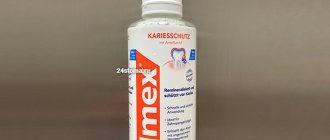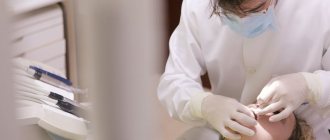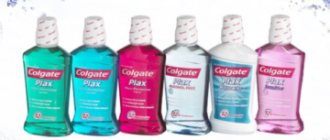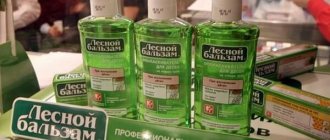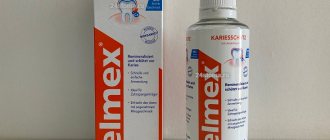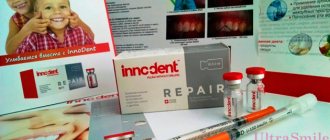A mouthwash is a special liquid that is used after brushing your teeth or for additional cleansing of the mouth during the day. The product is inexpensive and brings great benefits, but still remains insufficiently widespread. There are many different types of dental rinses sold on the modern market, so people are often lost in choice and don’t know which option is best.
Why do you need a rinse aid?
Mouth rinses are used for the prevention and treatment of dental diseases. Their use provides more thorough dental care and reduces the risk of developing inflammatory diseases.
Main functions of mouth rinse :
- cleaning the spaces between teeth from bacterial agents and food debris;
- breath freshening;
- maintaining dental health and accelerating recovery in case of disease development;
- prevention of complications;
- eliminating bleeding gums;
- reduction of tooth sensitivity.
Dentists at the Nurimed clinic recommend the use of special mouth rinses as part of caries prevention.
Classification
The classification divides mouth products into two main groups:
- hygienic (cosmetic) - in fact, only masking the problem;
- medicinal - really eliminating it.
Hygienic ones include deodorizing mouth rinses - refreshing, eliminating unpleasant odor, and whitening - brightening tooth enamel.
Therapeutic rinses can be divided into:
- anti-caries;
- painkillers (anti-inflammatory);
- antibacterial;
- against gingivitis and plaque;
- against tartar;
- astringents.
Anti-caries products usually contain a lot of fluoride, which strengthens teeth well. They are often prescribed to those who wear braces.
Pain-relieving mouth rinses are designed to relieve acute pain associated with certain oral diseases. You can buy mouthwashes with this effect in pharmacies.
Antibacterial rinses destroy harmful microorganisms and keep gums healthy; they usually have a complex synthetic composition.
Rinses that are designed to prevent gingivitis and plaque act on bacteria, slowing their growth in the mouth. If the product contains antiseptics, for example, triclosan, then it is used only with a prescription.
Anti-tartar products contain calcium citrate.
Astringents constrict blood vessels, thereby reducing their sensitivity, and form a film on nerve endings, protecting them from inflammation.
Mouthwash composition
Depending on the type of rinse aid, it may contain different components. However, the basic elements remain the same:
- Fluorine. This element is necessary to strengthen tooth enamel, it helps to avoid caries, and reduces the risk of developing increased abrasion and sensitivity. In modern liquids, manufacturers use a progressive component - amino fluoride. The amount of fluoride may vary, so it is recommended to take the option that your dentist recommends. Operating principle: after using the product, a protective film is formed on the enamel, from which fluoride gradually penetrates into the surface of the tooth over a couple of hours.
- Antiseptics. The liquid may contain: chlorhexidine, cetylpyridinium chloride, triclosan and some others. They prevent the active proliferation of bacterial agents in the mouth. Therefore, the rinse helps prevent gingivitis, stomatitis, and treat periodontitis. You can use antiseptic products without harm for 2-3 weeks.
- Alcohol. Included in most brands. It is the best preservative and solvent, but its percentage composition may vary. When choosing a product for a child, you need to pay special attention to this point and purchase an alcohol-free mouth rinse.
- Xylitol. A substance with a sweet taste, but unlike regular sugar, it strengthens enamel and reduces the risk of developing caries.
- Plant extracts. Usually, extracts of medicinal plants are added that have anti-inflammatory, soothing, strengthening, and restorative effects. You need to carefully read the composition and make sure that you are not allergic to herbal ingredients.
With essential oil
It is better to prepare rinses with essential oils in alcohol for long-term storage.
There are 2 simple recipes:
- Mix 200 ml of vodka, 20 drops of mint oil, 15 thyme, 5 sage and 5 myrrh. A teaspoon of the mixture is added to a glass of water before each rinse.
- Mix 200 ml of vodka, 10 drops of lemon juice, 15 tea tree oil, 10 lavender. This product also has a whitening effect. Applies like the previous one.
A good antibacterial rinse would be one with tea tree oil and mint. To prepare, you need to take 200 ml of water, 5 drops of mint oil and 5 tea tree oil. This product will give you a feeling of freshness and cleanliness.
Other recipes for natural alcohol-based mouthwashes:
- 200 g of vodka is mixed with 500 ml of water, 30 ml of glycerin and 10 ml of aloe juice are added to the solution. The mixture is brought to a boil, then 20 drops of mint oil are added.
- Add 5 drops of mint oil and 5 mg of cinnamon powder to a glass of vodka. This remedy should sit for several days. After preparation, the mixture is filtered and used for rinsing.
- Mix two teaspoons of mint and sage, add 5 tablespoons of red sandalwood powder. The mixture is poured with a liter of water and 200 ml of alcohol. The product is infused for a week in a dark place.
- The container contains 50 ml of water, 100 ml of vodka, 15 drops of lemon juice and 20 bergamot oil. The contents are shaken and infused for 7 days. Before use, a teaspoon of infusion is diluted in 50 ml of water.
Beneficial properties of mouth rinse
The use of a rinse is recommended for all people, even those with absolutely healthy teeth. Useful properties of the rinse aid:
- cleansing the surface of the teeth from plaque, which begins to form almost immediately after classical brushing with a toothbrush;
- protection against caries, help for sensitive teeth;
- elimination of unpleasant odor (its source is most often dental plaque);
- antibacterial effect of mouth rinse (prescribed after dental surgery to prevent infection);
- prevention of the formation of tartar, dissolution of the initial formations of hard plaque.
Even the most thorough brushing of your teeth with the right brush and the perfect toothpaste will not help get rid of the amount of bacteria that the mouthwash destroys.
Is mouthwash beneficial or harmful?
Few people pay attention to the composition of mouth rinses. But in vain. They may contain harmful substances that will damage both tooth enamel and gums. And this is already fraught with very expensive dental consequences.
Composition of mouth rinses
- One of these harmful substances is triclosan - it kills not only harmful but also beneficial bacteria. It has a direct effect on the muscles of the dental cavity, reducing their activity, which leads to such an unpleasant phenomenon as atrophy. With frequent use of triclosan, some pathogenic bacteria become resistant to its action, which reduces the benefit of its use to zero.
- Alcohol can irritate the mucous membranes and cause dry mouth.
- The next element is fluorine . Today it has become overused. Fluoride is added in huge doses to toothpastes and mouthwashes. And everything in life, including useful things, as we know, is good in moderation. Of course, fluoride is good for teeth, but only in small quantities. Unfortunately, the advertising industry is silent about this important fact. Excess fluoride destroys tooth enamel. And this leads to yellowing and darkening of the teeth and the occurrence of fluorosis - the enamel becomes fragile, the teeth become covered with red or brown spots, defects in the dental tissue appear and even the formation of holes.
- Calcium - in excessive quantities can cause nausea, vomiting, and constant thirst. Increased calcium intake is strictly not recommended for pregnant women, because... increases the risk of birth injuries and leads to placental calcenosis, which interferes with normal fetal nutrition.
- Neovitin is not recommended for pregnant and lactating women and people with carbohydrate metabolism disorders.
- Calcium quote - Allergic reactions sometimes occur: rash, itching, hives, stomach pain, nausea, flatulence, diarrhea or constipation.
- Chlorhexidine - with frequent use of chlorhexidine, brown or black spots appear on the teeth - the amount of plaque and tartar will increase. Dryness and burning in the mouth also occurs.
- Cetylpyridinium chloride is contraindicated during pregnancy and breastfeeding.
To use or not to use whitening and cosmetic rinses is up to you. It is important to remember that beneficial substances will not be able to penetrate behind the plaque film on their own, and therefore, without thorough hygiene, the use of any rinses is virtually useless. Therefore, they can only be used after thoroughly brushing your teeth with toothpaste.
Therapeutic rinses can help treat some gum inflammation if used strictly as recommended by your doctor. If you want to protect yourself from unpleasant consequences, ask your dentist to recommend an effective and safe product, do not use it too often and do not exceed the concentration specified in the instructions. If the medicinal rinse prescribed to you causes extremely discomfort, it is better to tell your doctor.
Number of views 2,605
How to use mouthwash?
Using the mouthwash is very easy. Use it after regular teeth brushing. It is best to consider what kind of toothpaste you use when choosing a liquid. For example, if the paste contains a large amount of fluoride, then it is better to choose a rinse aid with a reduced content.
Dentists recommend rinsing your mouth after each brushing; you can additionally use the product after meals. There is no need to rinse your mouth with water after using a special liquid, since all active ingredients are washed off and the usefulness of the rinse is reduced.
Despite the fact that the components of the product are not intended to enter the gastrointestinal tract, swallowing a small amount of mouthwash is harmless to humans.
How to do
Place rosemary and water in a saucepan and bring to a boil. Let simmer for 15 minutes, remove from heat and leave to cool. Strain into a clean, sterile bottle and store in your bathroom, ready to use.
Advice
Another quick and easy homemade mouthwash can be made by infusing cleansing herbs such as peppermint, marjoram, sage and thyme. For more information, check out how to make herbal infusions
Contraindications for use
In some cases, using mouthwash is not appropriate. There are few such situations, but dentists always warn about possible contraindications. These include:
- Treatment of alcohol dependence (does not apply to products that do not contain alcohol).
- Pregnancy and breastfeeding (it cannot be said that good and high-quality products can somehow harm the mother or child; caution is due to the fact that clinical trials are not conducted on pregnant and lactating women).
- Allergic reactions to components of the liquid (most often, allergies to plant substances or antiseptics are observed).
- Children under 6 years old, and if the product contains ethyl alcohol - up to 12 years old (usually the packaging indicates at what age the liquid can be used).
If you are not sure whether you have an allergic reaction to any of the components of the product, do a test. Apply a small amount of liquid to the skin and wait a quarter of an hour. The presence of a rash, swelling, or severe hyperemia indicates an allergy to one or more constituent substances.
Cons of mouthwashes
- For the mouthwash to work
, you need to rinse your mouth not for 10 seconds, as most people do, but for 30–40 seconds. At first it’s not easy: out of habit, the facial muscles quickly get tired. But with daily rinsing, they become trained. - Mouthwashes should not be swallowed
, even those that say they are harmless on the packaging. Most products contain ethanol. It effectively fights bacteria, but if accidentally swallowed it can cause dysbacteriosis. In addition, within 10-15 minutes after rinsing, the alcohol test gives a positive result: take this into account if you drive a car. - Cheap rinses eliminate symptoms
, not causes, as they consist of water and herbal infusions or green tea. They simply dull bad breath, but do not eliminate the cause of its occurrence. - Some rinses contain synthetic dyes
(CI 42090, CI 19140, CI 17200), preservatives and foaming agents that cause dry mucous membranes and can even stain the enamel. - Rinses containing chlorhexidine can cause inflammation
and dryness of the mucous membranes. Such drugs are contraindicated for children. - Rinses containing the foaming agent Sodium Lauryl Sulfate (SLS) also cause dry mucous membranes
and neutralize the effect of chlorhexidine.
Which mouthwash is best?
Before choosing a product, you should understand for what purpose you want to use it. If you want to improve the color of your enamel, it is better to purchase special whitening rinses that are used according to the instructions for a certain amount of time.
Fluoridated liquids are used to strengthen enamel and prevent caries. Check the fluoride concentration in the toothpaste you are using first.
If there are inflammatory processes in the oral cavity, it is recommended to take a product containing an antiseptic. Mouthwash for gum inflammation is used continuously for up to 3 weeks, preferably as prescribed by a dentist. For gum problems, products with plant extracts are used for a long time.
In some cases, a person needs to strengthen his teeth and reduce the risk of tooth loss. Elderly people are especially susceptible to this problem. Mouthwash is good for periodontal disease.
It is best to consult with a dentist at the Nurimed clinic before purchasing. The specialist will examine the oral cavity, identify the main problems and recommend suitable rinses.
Clinical researches
ASEPTA rinses are clinically proven effective. For example, repeated clinical studies have proven that the two-component oral product ASEPTA ACTIVE more effectively combats the causes of inflammation and bleeding compared to single-component rinses - it reduces inflammation by 41% and reduces bleeding gums by 43%.
Sources:
- The role of anti-inflammatory rinse in the treatment of periodontal diseases (L.Yu. Orekhova, A.A. Leontyev, S.B. Ulitovsky) L.Yu. OREKHOVA, Doctor of Medical Sciences, Prof., Head of Department; A.A. LEONTIEV, dentist; S.B. ULITOVSKY, Doctor of Medical Sciences, Prof. Department of Therapeutic Dentistry of St. Petersburg State Medical University named after. acad. I. P. Pavlova
- Report on determining/confirming the preventive properties of commercially produced personal oral hygiene products: Asepta toothpaste used in combination with Asepta mouthwash and Asepta gum balm Head. Department of PFS Doctor of Medical Sciences Professor S.B. Ulitovsky St. Petersburg State Medical University named after Academician I.P. Pavlova. Faculty of Dentistry. Department of Preventive Dentistry.
Recipes based on natural remedies
A decoction of oak bark will help get rid of bleeding gums and strengthen them. You can supplement the mixture with sage, chamomile or rose hips. If only oak bark is used, it is better to cook it in a water bath: a couple of tablespoons of crushed oak bark are placed in an enamel bowl and filled with water. The dishes are placed in a saucepan with water; it all needs to be heated for about half an hour.
When adding other herbs, a tablespoon of the mixture per one and a half glasses of water is enough. Bring to a boil and simmer a little under the lid, pour into a convenient container and cool. An important point: it is better to store the product no longer than a day, after which all the beneficial substances will evaporate.
For fresh breath, mouthwashes with mint are always useful. For half a liter of water you will need two tablespoons of dry green tea without additives and natural dried mint. Pour the herbs with clean hot water (500 ml),
leave to infuse overnight. In the morning, add a teaspoon each of benzoin tincture and myrrh infusion. Keep refrigerated.
An unusual recipe that will get rid of germs. It is only suitable for adults: add a tablespoon of thyme, myrrh and sage (dry herbs) to a cup of cognac and leave to steep for two weeks. The infusion is filtered and diluted with water (1:1) before rinsing. For a light whitening effect, you can add a spoonful of lemon juice.
"Kitchen" products
One of the most famous and simple recipes is a rinse with soda or salt. One teaspoon of salt and 1/2 teaspoon of soda are dissolved in a glass of warm boiled water, the resulting composition is thoroughly stirred until all particles are completely dissolved.
You can use a rinse with natural apple cider vinegar to combat swelling. You will need to mix a third of a glass of vinegar, a teaspoon of glycerin, 10 drops each of mint and lemon oil, 5 drops of myrrh oil. The mixture should be infused for four days in a dark place, then stored in the refrigerator and shaken before use. For rinsing, half a teaspoon per glass of water is enough.
A teaspoon of baking soda and five drops of iodine will help you quickly get rid of acute toothache: dilute this with a glass of boiled water, rinse for at least two to three minutes, up to five times a day.
Terms of use
One of the disadvantages of homemade mouthwash is that it does not last long. This pharmaceutical product can stand on the shelf for months: homemade decoctions can last in the refrigerator for a maximum
a week, and more often - just a couple of days. Therefore, stocks must be replenished regularly.
Mouth rinsing time is up to two minutes, and most products can only be used by adults. It is best to consult a doctor before giving mouthwash to your child. It is better to dilute children's portions with water in larger proportions than for adults.
Do not swallow mouthwash under any circumstances. In addition, it is worth remembering: it is not a complete alternative to toothbrushing; oral care must be comprehensive.
